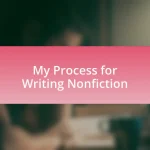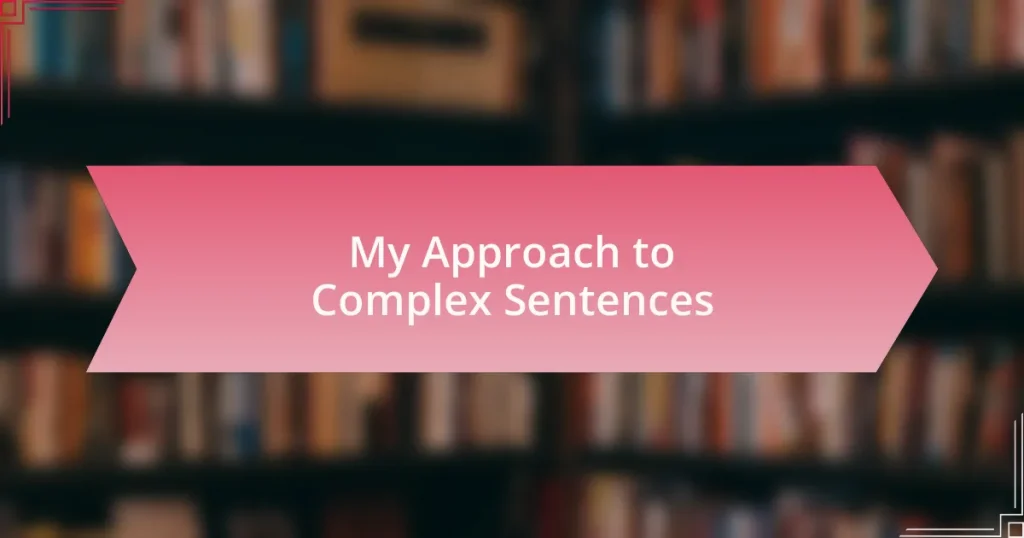Key takeaways:
- Complex sentences enhance communication by expressing intricate thoughts and clarifying relationships between ideas.
- They consist of an independent clause and at least one dependent clause, enabling a nuanced expression of thoughts.
- Common mistakes include misuse of subordinate conjunctions, overly long sentences, and incorrect placement of dependent clauses.
- Mastering complex sentences involves focusing on clarity, varying sentence structure, and reading widely for inspiration.
Author: Clara Whitfield
Bio: Clara Whitfield is a captivating storyteller and acclaimed author known for her rich, character-driven narratives that explore the complexities of human relationships. With a background in psychology and a passion for literature, Clara weaves intricate plots that resonate with readers on multiple levels. Her debut novel, “Echoes of the Heart,” received critical acclaim and was a finalist for several literary awards. When she’s not writing, Clara enjoys hiking in nature, experimenting in the kitchen, and engaging with her vibrant community of fellow writers. She resides in Portland, Oregon, where she draws inspiration from the lush surroundings and eclectic culture.
Understanding complex sentences
Complex sentences can seem daunting at first, but they add depth to our communication. I remember struggling with them in school; I would often use simple sentences to get my point across and miss the nuances of expression. Have you ever found yourself wishing to convey more than just the basic facts? That’s where complex sentences shine.
At their core, complex sentences consist of an independent clause and at least one dependent clause. This structure allows us to connect ideas in a way that reflects our thoughts more accurately. For instance, when I say, “Although it was raining, I decided to go for a walk,” I’m not just sharing two facts; I’m revealing a choice influenced by circumstances. Isn’t it fascinating how a simple addition can transform a sentence’s meaning?
Using complex sentences also helps clarify relationships between ideas, which is something I’ve learned over time. When I started incorporating them into my writing, I noticed my points became clearer and more nuanced. Have you experienced that moment when a well-constructed sentence resonates perfectly? It’s like finding the right key to unlock a door, revealing layers of meaning that plain sentences just can’t provide.
Importance of complex sentences
Complex sentences hold immense importance in our communication because they offer the ability to express intricate thoughts and feelings. I remember once writing a letter to a friend after a challenging day. Instead of simply stating, “I was stressed,” I wrote, “Although I was stressed after a long day at work, I still felt grateful for the support of my friends.” This transformation not only conveyed my emotional state but also introduced another layer of appreciation—something simple sentences often overlook.
They also enable us to create smoother transitions between ideas, enhancing the flow of our writing. For instance, I once worked on a project where clarity was crucial, and I articulated my points using complex sentences. This allowed me to guide my audience through my reasoning step by step. Have you ever struggled with making your argument cohesive? By linking ideas through dependent clauses, we can make our writing not just clear, but also engaging.
Moreover, complex sentences often reflect the complexity of our thoughts. I find that when I express layered thoughts, it invites readers to engage on a deeper level. It’s like having a conversation with a friend, where both parties share not just opinions but insights. Isn’t it remarkable how language can mirror our intricate human experiences?
Structure of complex sentences
Complex sentences consist of an independent clause and one or more dependent clauses, allowing for a more nuanced expression of thoughts. For example, when I reflect on times spent with family, I might say, “While we often bicker about trivial matters, our love remains unshakeable.” This structure not only conveys the idea of conflict but also highlights the strength of our bond.
Dependent clauses, which can begin with words like ‘because,’ ‘although,’ or ‘if,’ add depth to the main idea. I recall a moment when I explained a difficult decision to a colleague, using a complex sentence: “Because I was passionate about the project, I chose to invest extra hours, even when it meant sacrificing my personal time.” This approach helped to frame my choices in the context of my commitment, enriching the conversation.
Understanding how to properly structure complex sentences can elevate your writing significantly. Have you ever noticed how an idea can shift dramatically with the right wording? I once struggled with this concept, but once I grasped it, my ability to articulate my thoughts improved immensely. The ability to weave together different ideas is crucial for clear communication – it’s almost like creating a tapestry of words that draws the reader in.
Common mistakes in complex sentences
One common mistake I often see in complex sentences is the misuse of subordinate conjunctions. For instance, I’ve encountered sentences where someone uses “although” but fails to create a contrasting relationship effectively. This can lead to confusion. I remember my friend struggling with a sentence that read, “Although she loves to cook, she burned dinner,” when the emphasis should have been on the humor of the situation rather than an unbalanced comparison.
Another pitfall is the tendency to create overly long sentences without proper punctuation. This can result in a run-on sentence that becomes difficult to read. I once wrote a complex sentence that felt like a marathon. It included so many clauses that by the time I reached the end, I had forgotten the beginning. Shortening those can make the point clearer. Breaking it down not only aids the reader’s comprehension but also sharpens the writing.
Also, it’s worth mentioning how improperly placing dependent clauses can distort meaning. I once wrote, “I went to the store after I finished my homework,” when I actually wanted to emphasize that my homework was a priority. In such cases, rearranging the clauses can clarify the sequence of events. Have you ever found yourself in a similar situation? Reflecting on it helps me ensure I convey my intended message more accurately.
Tips for mastering complex sentences
To master complex sentences, one vital tip is to focus on clarity. I once decided to elevate my writing with a beautifully intricate sentence. As I crafted layers of meaning, I couldn’t help but feel proud. However, when I reread it, I realized that my reader might just see a tangled web of phrases. I found it helpful to ask myself, “Will my audience grasp my message?” If the answer is uncertain, that’s a cue to simplify or break it down.
Another effective strategy is to consciously vary your sentence structure. While experimenting with complex sentences, I discovered that mixing in shorter ones can create rhythm. For example, after a long, detailed sentence, I would insert a brief statement to highlight an essential point. This not only keeps the reader’s interest but also emphasizes key ideas more effectively. Have you tried that technique? It can be a game changer.
Moreover, reading widely can significantly improve your command of complex sentences. I can still recall the epiphany I had while reading classic literature—seeing how skilled authors weave intricate thoughts together opened my eyes. I would often ask myself how they maintained balance and clarity amid complexity. Analyzing their techniques sharpened my skills and enhanced my writing. So, when you’re immersed in a new book or article, pay close attention—there’s a wealth of knowledge to uncover.















